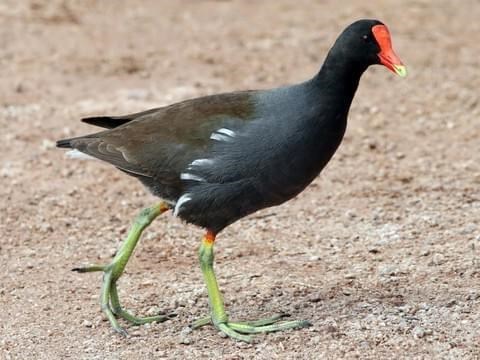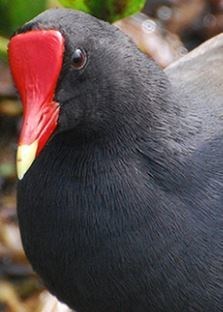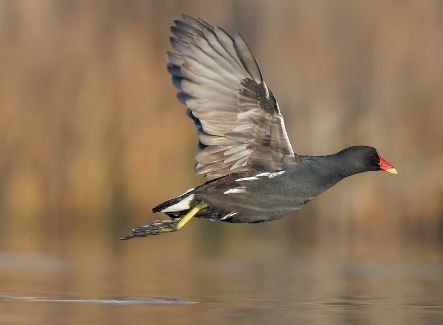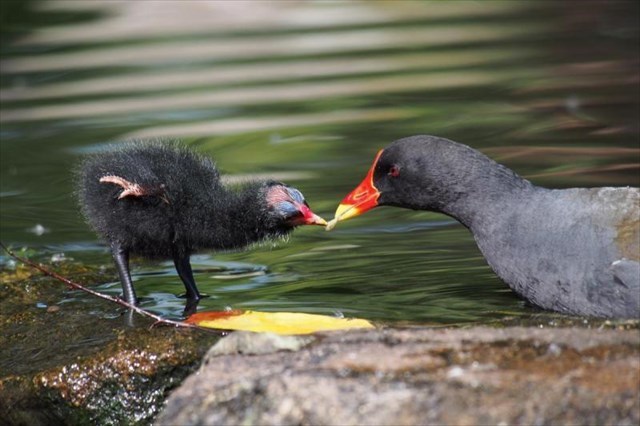WS#2: Swamp Chicken
 The cache, a camo-taped 35mm film canister, is hidden at the side of this lovely shady riverside trail from which this commonly seen bird was seen quietly feeding at the edge of the river.
The cache, a camo-taped 35mm film canister, is hidden at the side of this lovely shady riverside trail from which this commonly seen bird was seen quietly feeding at the edge of the river.
To reach the cache location: (from the west) park @ or near N 53 54.957 W 1 44.698 on the approach road to the old mill complex and after securing your car, cross the road and pick up the small trail heading across the top of the woodland, down to and along the river.
(from the east) park @ or near N 53 54.578 W 1 43.635 in the lay-by and pass through the gate at its west end into the field and across to the trail running alongside the river.
The common moorhen (Gallinula chloropus) (aka waterhen, swamp chicken and common gallanule) is found across many parts of the Old World and is the most widely distributed member of the rail family (Rallidae).12 subspecies exist around the world, most differing only in size or brightness of plumage - the one occurring in UK is G.C. chloropus.
The name mor-hen has been recorded in English since the 13th century. The word moor here is an old  sense meaning marsh - it is not usually found in moorland. The scientific name comes the Latin Gallinula (small hen or chicken) and the Greek chloropus (khloros green or yellow pous foot)
sense meaning marsh - it is not usually found in moorland. The scientific name comes the Latin Gallinula (small hen or chicken) and the Greek chloropus (khloros green or yellow pous foot)
It may be found around any pond, lake, stream or river, or even ditches in farmland and can live in cities as well as the countryside. In the UK they breed in in lowland areas, especially in central and eastern England. They're scarce in northern Scotland and the uplands of Wales and northern England. UK breeding birds are residents and seldom travel far.
It is distinctive, with dark plumage apart from the white undertail, yellow legs and a red frontal shield. The young are browner and lack the red shield.
It gives a wide range of gargling calls (listen here and here) and will emit loud hisses when threatened. A midlarge sized rail, it is 30-38 cm long with a 50-62 cm wingspan and weighs 192-500 g. It has long toes that makes it possible to walk on soft mud and floating vegetation. The toes have no lobes or webbing to help in swimming, but the moorhen is a good swimmer anyway. It sometimes lifts its feet out of the water in front of the body while swimming, perhaps to pass over vegetation.
 It is a common breeding bird in marsh environments, well-vegetated lakes and even in city parks. Populations in areas where the waters freeze, such as eastern Europe, will migrate to more temperate climes
It is a common breeding bird in marsh environments, well-vegetated lakes and even in city parks. Populations in areas where the waters freeze, such as eastern Europe, will migrate to more temperate climes
It eats a wide variety of vegetable material and small aquatic creatures. It forages beside or in the water, sometimes walking on lilypads or upending in the water to feed. It is often secretive, but can become tame in some areas. Despite loss of habitat in parts of its range, it is still plentiful and widespread.
It is territorial during breeding season. The nest is a basket built on the ground in dense vegetation. Laying starts in spring, between mid-March and mid-May. About 8 eggs are usually laid early in the season; a brood later in the year usually has only up to 5–8.  Nests may be re-used by different females. Incubation lasts about 3 weeks with both parents caring for the young which fledge after 40-50 days, become independent a few weeks later and may raise their first brood the next spring. When threatened, the young may cling to the parents' body, after which the adult birds fly away to safety, carrying their offspring with them. Newly hatched chicks have spurs on their wings that help them climb into the nest or grab emergent vegetation.
Nests may be re-used by different females. Incubation lasts about 3 weeks with both parents caring for the young which fledge after 40-50 days, become independent a few weeks later and may raise their first brood the next spring. When threatened, the young may cling to the parents' body, after which the adult birds fly away to safety, carrying their offspring with them. Newly hatched chicks have spurs on their wings that help them climb into the nest or grab emergent vegetation.
See here for more info including photos, videos and sound recordings.